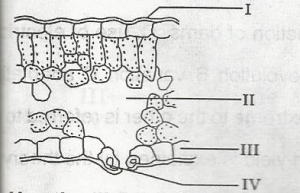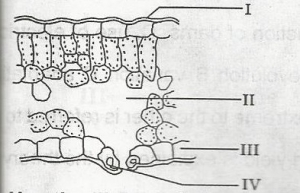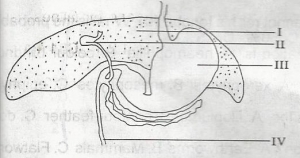Year :
2009
Title :
Biology
Exam :
JAMB Exam
Paper 1 | Objectives
31 - 40 of 50 Questions
| # | Question | Ans |
|---|---|---|
| 31. |
A health condition that is known to have resulted from gene mutation is? A. typhoid B. rabies C. sickle-cell anaemia D. sleeping sickness |
|
| 32. |
Plants that grow in an area that is neither too wet nor too dry are A. xerophytes B. mesophytes C. epiphytes D. hydrophytes |
|
| 33. |
The part of a domestic fowl responsible for preventing heat loss is the? A. filoplume B. contour feather C. down feather D. quill Detailed SolutionDOWN FEATHERS ARE THOSE WHICH HELP TO KEEP THE BIRDS'S BODY WARM.THEY ARE SOFT AND FLUFFY, FOUND ON THE INNER SIDE OF BIRD'S BODY . There is an explanation video available below. |
|
| 34. |
Which of the following animals is most adapted for water conservation? A. earthworms B. mammals C. flatworms D. insects Detailed SolutionInsects are widespread and adapted to all types of environment even the driest and hottest places on earth.There is an explanation video available below. |
|
| 35. |
The specialized pigment cells that are involved in colouration and colour change in animals? A. xanthophyll B. chromatophores C. chlorophyll D. melanin Detailed SolutionChromatophores are cells that produce color, of which many types are pigment-containing cells, or groups of cells, found in a wide range of animals including amphibians, fish, reptiles, crustaceans and cephalopods.Mammals and birds, in contrast, have a class of cells called melanocytes for coloration. There is an explanation video available below. |
|
| 36. |
During the dry season in the tropics, the body metabolism of some animals slow to a minimal level in a process referred to as? A. hibernation B. aestivation C. dormancy D. senescense Detailed SolutionAestivation is characterized by inactivity and a lowered metabolic rate, that is entered in response to high temperatures and arid conditions. It takes place during times of heat and dryness, the hot dry season, which are often the summer months.There is an explanation video available below. |
|
| 37. |
According to Darwin, the driving force behind evolutionary change is A. natural selection B. genetic drift C. mutation D. gene flow |
|
| 38. |
 Use the diagram above to answer this question. A. l B. ll C. lll D. lV Detailed SolutionStomata regulate gas exchange between the plant and environment and control of water loss by changing the size of the stomatal pore.Guard cells are cells surrounding each stoma. They help to regulate the rate of transpiration by opening and closing the stomata. There is an explanation video available below. |
|
| 39. |
 Use the diagram above to answer this question. A. spongy mesophyll B. upper epidemis C. cuticle D. vein Detailed SolutionPlant cuticle is the outermost layer of plants, which covers leaves, fruits, flowers, and non-woody stems of higher plants.It protects plants against drought, extreme temperatures, UV radiation, chemical attack, mechanical injuries, and pathogen/pest infection. There is an explanation video available below. |
|
| 40. |
 Use the diagram above to answer this question. A. l B. ll C. lll D. lV Detailed SolutionFat emulsification is the process of increasing the surface area of fats in the small intestine by grouping them into small clusters.This is the responsibility of bile, a liquid created by the liver and stored in the gallbladder. Actual digestion of the fats is then accomplished by lipase, an enzyme from the pancreas There is an explanation video available below. |
| 31. |
A health condition that is known to have resulted from gene mutation is? A. typhoid B. rabies C. sickle-cell anaemia D. sleeping sickness |
|
| 32. |
Plants that grow in an area that is neither too wet nor too dry are A. xerophytes B. mesophytes C. epiphytes D. hydrophytes |
|
| 33. |
The part of a domestic fowl responsible for preventing heat loss is the? A. filoplume B. contour feather C. down feather D. quill Detailed SolutionDOWN FEATHERS ARE THOSE WHICH HELP TO KEEP THE BIRDS'S BODY WARM.THEY ARE SOFT AND FLUFFY, FOUND ON THE INNER SIDE OF BIRD'S BODY . There is an explanation video available below. |
|
| 34. |
Which of the following animals is most adapted for water conservation? A. earthworms B. mammals C. flatworms D. insects Detailed SolutionInsects are widespread and adapted to all types of environment even the driest and hottest places on earth.There is an explanation video available below. |
|
| 35. |
The specialized pigment cells that are involved in colouration and colour change in animals? A. xanthophyll B. chromatophores C. chlorophyll D. melanin Detailed SolutionChromatophores are cells that produce color, of which many types are pigment-containing cells, or groups of cells, found in a wide range of animals including amphibians, fish, reptiles, crustaceans and cephalopods.Mammals and birds, in contrast, have a class of cells called melanocytes for coloration. There is an explanation video available below. |
| 36. |
During the dry season in the tropics, the body metabolism of some animals slow to a minimal level in a process referred to as? A. hibernation B. aestivation C. dormancy D. senescense Detailed SolutionAestivation is characterized by inactivity and a lowered metabolic rate, that is entered in response to high temperatures and arid conditions. It takes place during times of heat and dryness, the hot dry season, which are often the summer months.There is an explanation video available below. |
|
| 37. |
According to Darwin, the driving force behind evolutionary change is A. natural selection B. genetic drift C. mutation D. gene flow |
|
| 38. |
 Use the diagram above to answer this question. A. l B. ll C. lll D. lV Detailed SolutionStomata regulate gas exchange between the plant and environment and control of water loss by changing the size of the stomatal pore.Guard cells are cells surrounding each stoma. They help to regulate the rate of transpiration by opening and closing the stomata. There is an explanation video available below. |
|
| 39. |
 Use the diagram above to answer this question. A. spongy mesophyll B. upper epidemis C. cuticle D. vein Detailed SolutionPlant cuticle is the outermost layer of plants, which covers leaves, fruits, flowers, and non-woody stems of higher plants.It protects plants against drought, extreme temperatures, UV radiation, chemical attack, mechanical injuries, and pathogen/pest infection. There is an explanation video available below. |
|
| 40. |
 Use the diagram above to answer this question. A. l B. ll C. lll D. lV Detailed SolutionFat emulsification is the process of increasing the surface area of fats in the small intestine by grouping them into small clusters.This is the responsibility of bile, a liquid created by the liver and stored in the gallbladder. Actual digestion of the fats is then accomplished by lipase, an enzyme from the pancreas There is an explanation video available below. |